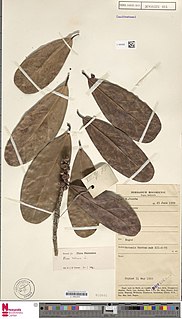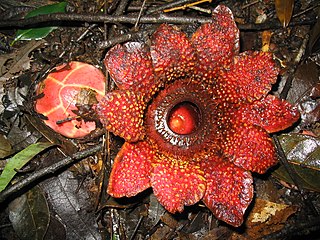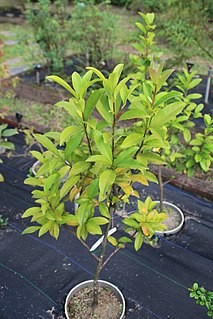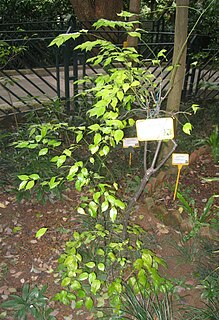
Pentaphragma is a genus of flowering plants. Pentaphragma is the sole genus in Pentaphragmataceae, a family in the order Asterales. These species are fleshy herbs, with asymmetrical leaf blades.They are found in Southeast Asia.Pentaphragma is rayless, but eventually develops rays in at least one of the species studied. This is interpreted as related to secondary woodiness or upright habit within a predominantly herbaceous phylad. The vessel elements of Pentaphragma have features universally interpreted as primitive in dicotyledons: scalariform perforation plates with numerous bars; pit membrane remnants in perforations; scalariform lateral wall pitting; the genus also has fiber-tracheids with prominently bordered pits.The presence of occasional scalariform perforation plates, often aberrant, in secondary xylem of families of Asterales sensu lato - Campanulaceae, Pentaphragmataceae, Valerianaceae, and even Asteraceae - can be attributed to paedomorphosis, extending these plates into secondary xylem from primary xylem. Raylessness in Pentaphragma can be described in terms of secondary woodiness or paedomorphosis. The fact that fiber-tracheids are shorter than vessel elements in Pentaphragma is believed related to raylessness also, because some fiber-tracheids are produced from 'potential' ray areas.

Taiwanese Mandarin refers to any of the varieties of Mandarin Chinese spoken in Taiwan. The standard form of this language, called Guoyu, is the official national language of Taiwan taught in the education system and used in official communications. The core of this standard variety is described in the dictionary Guoyu Cidian (國語辭典) maintained by the Ministry of Education of Taiwan. It is based on the phonology of the Beijing dialect together with the grammar of vernacular Chinese. Guoyu closely resembles and is mutually intelligible with Standard Chinese, the official language of mainland China, with some divergences in pronunciation, vocabulary, and grammar.

Ficus retusa is a species of evergreen woody plant in the fig genus, native to the Malay Archipelago and Malesia floristic region. The species name has been widely mis-applied to Ficus microcarpa.

Sapria is a genus of parasitic flowering plants in the family Rafflesiaceae. It grows within roots of Vitis and Tetrastigma. The genus is limited to the tropical forests of South and South-east Asia.

Truncatella guerinii is a species of very small land snail that lives at the edge of the sea, a gastropod mollusk in the family Truncatellidae.
Utricularia heterosepala is a small carnivorous plant that belongs to the genus Utricularia.

Laportea aestuans, the West Indian woodnettle, is an annual herb of the Urticaceae or nettle family.
Didymoplexiella is a genus of flowering plants from the orchid family, Orchidaceae. It contains 8 known species native to Southeast Asia, with a few species extending northwards into Japan and southern China. These are mycoheterotropic plants lacking chlorophyll, obtaining nutrients from fungi in the soil.
- Didymoplexiella borneensis(Schltr.) Garay - Sarawak
- Didymoplexiella cinnabarinaTsukaya, M.Nakajima & H.Okada - Kalimantan
- Didymoplexiella denticulataAver. - Laos, Vietnam
- Didymoplexiella forcipata(J.J.Sm.) Garay - Kalimantan
- Didymoplexiella kinabaluensis(Carr) Seidenf. - Sabah
- Didymoplexiella ornata(Ridl.) Garay - Thailand, Vietnam, Malaysia, Borneo, Sumatra
- Didymoplexiella siamensis(Rolfe ex Downie) Seidenf. - Hainan, Taiwan, Japan, Ryukyu Islands, Thailand, Vietnam
- Didymoplexiella trichechus(J.J.Sm.) Garay - Sumatra, Bangka

Pyrenaria buisanensis is a species of tea endemic to Taiwan. It was first described by the Japanese botanist S. Sasaki in 1931, but the herbarium specimens were lost and the species identity remained dubious until a 2004 publication that reported its rediscovery and reclassified it as a species of Pyrenaria. Its status remains controversial, with some sources including in Pyrenaria microcarpa.
Vanilla shenzhenica is a species of Vanilla native to Guangdong and Hong Kong in China.
Malaxis sampoae is an Asian species of orchids. It has been found only in Taiwan.
Han Taiwanese or Taiwanese Han are a Taiwanese ethnic group, most of whom are of full or partial Han descent. According to the Executive Yuan Taiwan, they comprise 95 to 97 percent of the Taiwanese population, which also includes Austronesians and other non-Han people. Major waves of Han immigration occurred since the 17th century to the end of Chinese Civil War in 1949, with the exception of the Japanese colonial period (1895-1945). Han Taiwanese mainly speak three Chinese languages: Mandarin, Hokkien and Hakka.

Salix mesnyi is a species of willow native to southern and eastern China, Taiwan, and Vietnam. It can be found among shrubs near water growing 15 metres (49 ft) tall.

Ilex asprella, also known as rough-leaved holly and plum-leaved holly, is a deciduous shrub native in South East Asia. Ilex asprella is one of the few deciduous species in the family Aquifoliaceae.
Liparis sanamalabarica is a species of orchid native to India. It is endemic in southern Western Ghats in Wayanad district.
Camellia chinmeii is an endemic species of small evergreen tree. It is of the genus Camellia of flowering plants in the family Theaceae. C. chinmeii has sessile flowers, six to ten perules, four or five white, early deciduous petals, yellow radiating stamens that are separate to nearly-separate to the base, style 6–7 mm in length and fused 1/2 to 2/3 from the base, densely tomentose ovary. The globose fruit is with beaked or unbeaked capsule.

Lilium brownii is a species of lily native to Mainland China, Hong Kong, Kinmen and Matsu Islands as well as northern and central Vietnam and Kachin of Myanmar. Its common names include Hong Kong lily and Brown's lily.
Fagaropsis is a genus of flowering plants in the rue family (Rutaceae), native to Africa and Madagascar. Its inclusion in the subtribe Toddalioideae is controversial. Trees or shrubs, they are valued for their timber and used in traditional medicine.

Ficus benguetensis is a shrub or tree of the family Moraceae living at low altitudes in the Ryu Kyu Islands, Taiwan and in the Philippines but not in Palawan. It lives as an understorey tree in humid forest environment and along streams and rivers.












